Should I Be Riding Now?
Should bicyclists be riding now? Should bicyclists wear face masks now to avoid the risk of catching the COVID-19 disease?
Common sense suggests that masks help, but the US Centers for Disease Control until recently downplayed them. With masks in short supply, the highest priority has been to ensure first responders and medical professionals have protection.
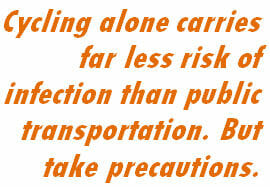
Judgments like that are about the Greater Good. They aren’t just about saving you in particular. They are based on epidemiological risk assessments from one point of view or another.
Good Health and the Greater Good
I like to think that I advocate for the Greater Good, but I do better at that if I am in good health. I might take that idea farther than some people. By 1978, bicycle helmets were becoming common, and like many people I wore one. But I was unique in wearing an industrial respirator mask when riding in the city.
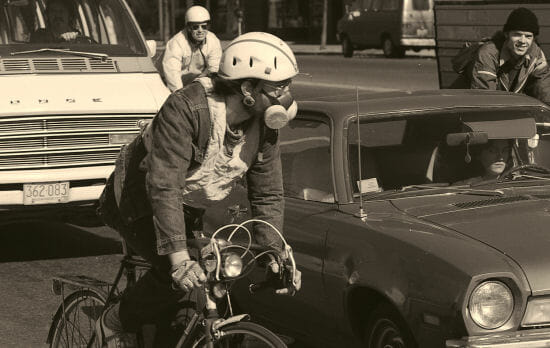
The author riding with helmet and mask in 1978 in Cambridge, Massachusetts. Photo by Anita Brewer-Siljeholm
Cities were smelly in 1978. Most cars did not have catalytic converters. Brake shoes were made of asbestos, and they shed asbestos fibers into the air. But my respirator worked great. Car exhaust had a heavy, oily smell back then, but it came through the mask odorless. Acrid diesel-bus exhaust exited the mask’s activated charcoal filters smelling like a fresh slice of whole-wheat toast.
If I hadn’t been wearing a respirator mask while cycling in the late 70s, the damage to my lungs and body would have been as significant as if I smoked cigarettes. Then, things got better. As pollution control on cars improved, I used the respirator less. It deteriorated in storage, and eventually I threw it away.
Now we have a different problem.
The pandemic has created a new and different problem. CyclingSavvy outdoor sessions have been postponed or canceled. Bicycle clubs have suspended their group ride programs. Should I ride at all? Wear a mask?
There is no absolute social distancing. The widely cited 6-foot rule reflects a balance of risk against what people will tolerate. The good news is that you don’t get infected by just one individual virus spore. Exhaustive research on the AIDS virus has established that there is a threshold level of contamination below which it does not take hold in a person. With the virus that causes COVID-19, the principle is the same, though the amount is not yet known. Individual susceptibility varies, and a higher dose appears to result in worse symptoms. Wearing a mask does lower the risk of catching the disease, or transmitting it.
Are Masks Practical?
I happen to have a few N95 masks left over from sanding and painting projects (opened box, not accepted for donation). I have shaved my beard — for the first time in 50 years — to make the masks work better.
My wife and I reserve the masks for shopping trips. We use them only once every several days, so they have time to decontaminate themselves. (Viruses die outside of the host animal’s body.) Three or four masks between us will probably hold out until supply improves. I wear eye-protection goggles over my eyeglasses. We also happen to have a couple of surgical masks.
My experience:
- An N95 mask proved practical only for short bicycle trips, especially in cold weather, because I couldn’t lift it off my face to blow my nose.
- A surgical mask is not practical for me when cycling in cool weather, because it doesn’t seal, and fogs my glasses. Lifting this mask is possible, though, without unbuckling the helmet.
- There are too many kinds of improvised cloth masks for me to come to a single conclusion. A bandana that hangs down and can be lifted up is probably going to allow blowing the nose.
- An industrial respirator mask is practical, though it could become uncomfortable on a long ride. The degree of protection it provides depends on the type of filters.
Any mask will somewhat impair breathing.
Should Bicyclists Wear Face Masks For Shopping Trips?
While I have access to a car, I prefer to shop by bicycle. The bicycle is more convenient when I am bringing home a small load. Cycling to the store alone generally carries far less risk of infection than riding public transportation. But when shopping, I have to interact with people, and sometimes go into a store.
Should bicyclists wear face masks for this kind of trip? Yes, at least when going into the store, but also if having to ride under crowded conditions.
For shopping trips, I wear gardening gloves with rubber fingers and palms. I carry a small bottle with disinfectant solution, and disinfectant wipes. I disinfect the shopping-cart handle before gripping it. I also disinfect my gloves, then my hands after I leave the store. When I get home I disinfect them again after removing the mask, goggles and helmet.
The reusable shopping bag in the picture below does not go into the store. Stores in Massachusetts don’t accept them any more, as they might carry infection. I use the bag after I’m done shopping, to increase the carrying capacity of my bicycle.
When I get home, I lay out items that I bought in the driveway to disinfect them, or pour food out into clean containers. Apartment dwellers have to disinfect indoors. There’s plenty of good information online about how to disinfect foods, and yourself after handling them. Here’s one example.
Should Bicyclists Wear Face Masks For Recreational Riding?
Should you wear a face mask while riding? Or not? Or just hang up the bicycle? Strategies are different if you’re riding solo or with someone else.
Each person’s circumstances are unique. In my case, it’s only a mile from my home to semi-rural outer suburbs. Traffic on roads there is very light now, and I’ll go on solo rides without wearing a mask.
Urban and suburban traffic is also light, though a friend — a high-mileage recreational road rider — has had to dodge many newbie wrong-way riders. (This is one more reason to stay away from riding on the edge of the road.)
Another friend who is a strong advocate for shared-use paths avoids them now, because they are crowded, largely with people who don’t know how to be safe on them.
In some places, notably New York State, masks are now required for everyone where social distancing is impossible. Spain and Italy have banned recreational cycling, allowing cycling only for some kinds of essential trips. That seems excessive to me, at least where I live, considering the low risk of contagion on lightly-used rural roads.
If You Ride With Another Person
The 6-foot rule doesn’t apply to bicyclists riding together, because bicyclists are moving, and the risk depends on which way the wind is blowing. One recommendation was to maintain 35-foot spacing, and greater at higher speeds. The front rider uses hand signals to indicate turns; the rear rider repeats them to confirm. Checking for confirmation is easier if the front rider uses a rear-view mirror.
Crash Risk
I do think about the risk of a crash that would require care in an already overburdened hospital. It could happen, but my last crash that required a doctor’s attention was in 1984, to no small extent because of the kind of skills that CyclingSavvy teaches. There is a balance to achieve.
I’ve been riding on the nearly empty semi-rural roads — without a mask, to stay in shape and avoid going stir-crazy. But you have to make up your own mind about this.
Something to Do at Home
CyclingSavvy online courses are available, and discounted during the pandemic. And my booklet Bicycling Street Smarts is for sale in print and as an e-book, with Keri Caffrey’s all-new illustrations (shameless promotion, sorry).
Even if you have hung the bicycle up for the duration, the time will come when you dust it off and ride again. This is a useful way to while away the time until then.

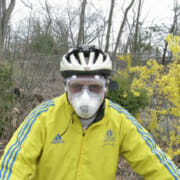
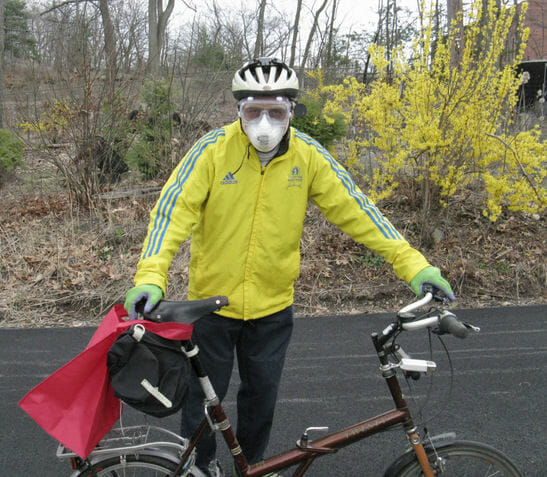


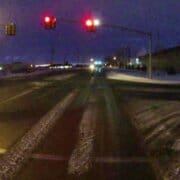

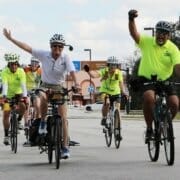

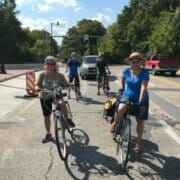
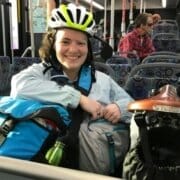
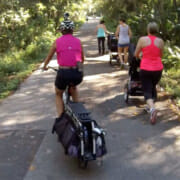



John, thanks for your thoughtful post and for demonstrating what is possible on a bike during this pandemic.
Yesterday, I rode 7-miles (each way) to my weekly physical therapy appointment, wearing an N95 mask throughout. It worked for me — primarily because, like you, I am used to wearing an N95 mask all day long during demolition and remodeling work, years of allergy sessions, and, in the past few years, wildfires affecting entire regional airsheds here in Northern California.
I will don my mask again shortly to ride my town bike to buy produce at our Saturday Farmer’s market. My glasses may fog up but it’s worth it: I know I am not putting anyone at risk in case I am one of those asymptomatic carriers of #COVID2019. (I would feel terrible if I discovered long after the fact that I had been a “Typhoid Mary for weeks.)
One last piece of advice for everyone who is still riding: make sure to keep the rubber side down! ;-)
Excellent, excellent, excellent John!!!
We’ve all been thinking about what you put to paper!
Thanks, be safe, healthy, & blessed!
I’ll suggest a change in wording. Rather than “The recommendation is to maintain 35-foot spacing, and greater at higher speeds,” it’s much more accurate to say “ONE recommendation (based only on a computer simulation) recommended 35 foot spacing.” That simulation of generic micro-particles in airflow was not peer reviewed, did not reference any clinical findings, did not account for the threshold level necessary for infection, etc. As far as I know, it has not been endorsed by CDC, WHO, U.S. departments of health or other reputable health organizations.
As with much “bike safety” advice, we need to be careful not to exaggerate danger and dissuade people from a very beneficial activity.
Thank you. Suggestion taken.
John, thank you for your intelligent guidance! When riding with 3 or more companions, I’ve been asking them to leave 4-5 car lengths between each of us to enable MVs to leap frog around us. We start out with the slowest in the lead and the strongest at the back. That presents a new challenge to those of us who are used to trying to close the gap or not fall off the back! :)
Agree with Frank. Spacings are hearsay and from the gut. Regarding face masks, they are being required in some locales whether they offer any benefit or not. My wife is a medical professional. She made a face mask for me out of operating room quality fabric. She copied operating room fittings. She also noted from personal experience that for fogging of glasses, it was common for OR personnel to tape the upper edge to their cheeks.
Tape won’t do for even short bicycle rides. In use I immediately found fogging to be a great nuisance. So I cut a narrow strip out of a scrap inner tube and crudely stitched it to the inside of the upper edge to form a gasket.
Fogging is still present. But it is no longer a nuisance. It no longer ponds on my lenses even during strenuous climbs in any weather conditions. Same at night. Possibly a more precise fitting would eliminate fogging. But I’m fine for now.
Another bother is mask cone collapse during heavy breathing. This becomes prevalent after the first laundering. It is bothersome when the mask is dry. It gets more bothersome as moisture collects. (I won’t speculate about mask effectiveness after moisture collects in the material.)
Using the same bendable-but-stiff material my wife used for the nose pinch fitting, I implemented a horizontal bulge support from ear-lobe to ear-lobe. I haven’t sewn it in yet. But the problem is solved even when the support is simply propped in.
The 3rd problem was how to deal with the ear straps. With eyeglasses, sweatband, helmet straps and now face mask ear straps, there was quite a bottleneck in the space between the top of my ear and my skull. A face mask strap arrangement that goes all the way around the head would work better for me. But instead of insisting on a re-design, I took a headband from a condemned ski mask and looped it through the face mask’s ear straps so those ear straps would route farther out from my ears.
You can ride hard with the mask on. It will require noticeably harder breathing. Consider that part of the benefit. And don’t worry, bystanders will not be able to see your gaping mouth as you chug by.
Until this pandemic is over, I’m simply riding alone!
Here in San Bernardino County (CA), the latest health department order (4/18/20) says “A face covering is not required for solitary outdoor activity…” I’ll keep one with me, just in case, and continue to follow the orders — also using good common sense.
Be safe & healthy everyone!